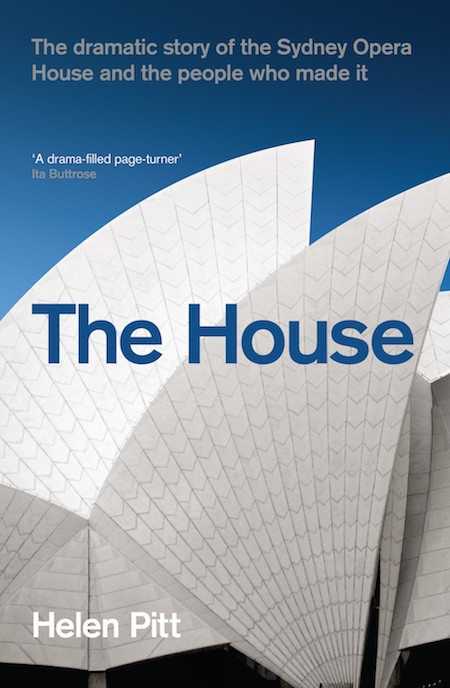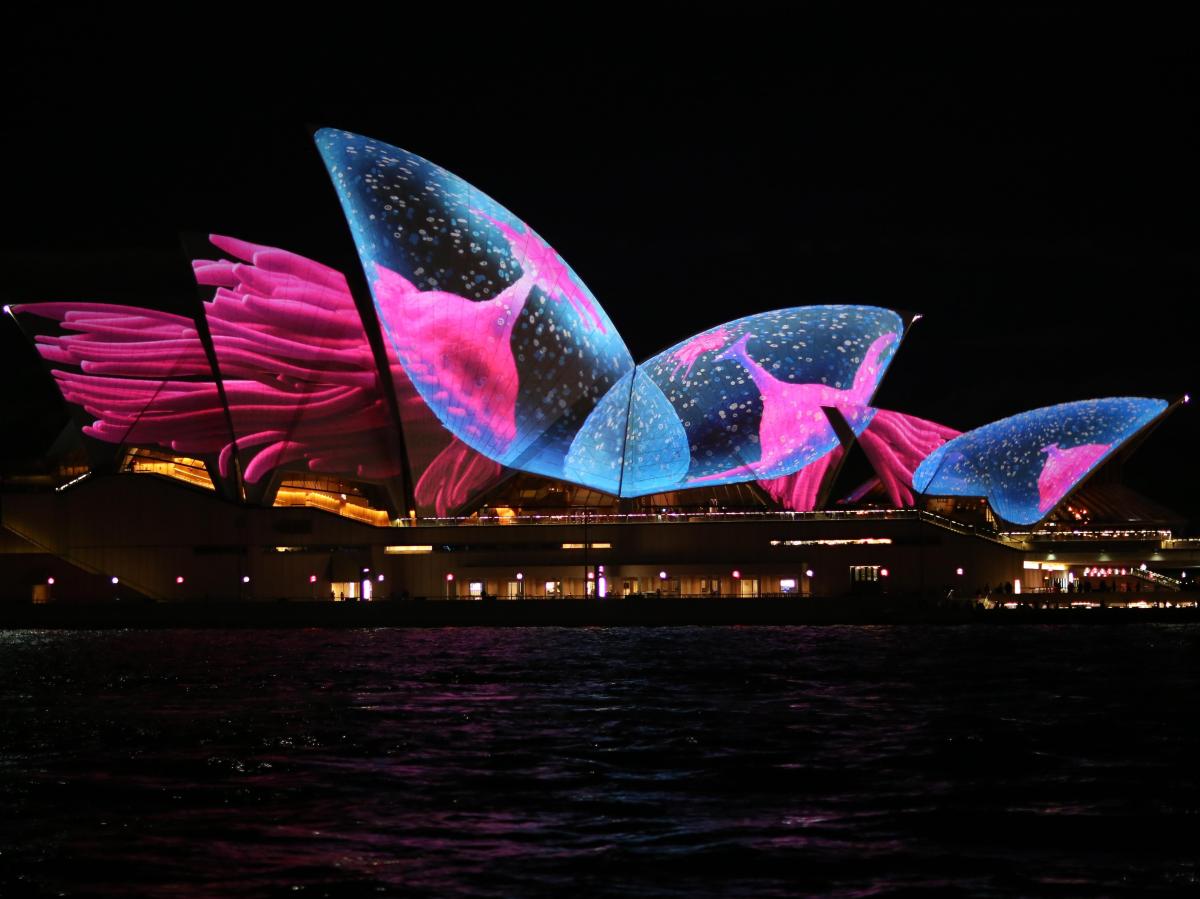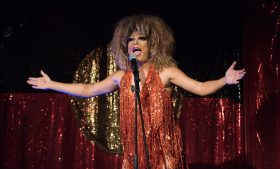Image: unsplash.com
‘Is this some kind of joke?’ Premier Cahill deadpanned when he got a sneak peek at the meticulously created model of the Opera House during Utzon’s first visit to Sydney. To be displayed in a glass case in the Town Hall, it was the centrepiece for the launch of the Sydney Opera House Appeal to raise money for the construction of the building.
Completely unsolicited, Peter TC Chow of Pymble had already made the first contribution to the Opera House Appeal (£10) in February, the month after Utzon’s win. Like Mr Chow, many Sydneysiders were eager to contribute. As well as the Labor Party caucus pledging to fund the Opera House with a lottery, Sydney’s Labor Lord Mayor Harry Jensen also pledged to launch a fund-raising appeal.
This is how Jørn Utzon and Erik Andersson came to be seated under the flags of Sweden, Denmark and Australia on the stage of Sydney Town Hall on the afternoon of 7 August 1957.
With them were the chairman of the Opera House Committee, Stan Haviland; the chairman of the ABC, Sir Richard Boyer; Premier Cahill; Lord Mayor Jensen; the leader of the state opposition, Pat Morton; and the vice-chancellor of Sydney University, the distinguished historian Professor Stephen Roberts.
A wildly enthusiastic crowd of 2500 people packed the Town Hall, stamping their feet, clapping and cheering as Harry Jensen read out a list of first contributions that included the Sydney City Council with £100,000 over five years.
Town Hall officials said the audience was the most emotional they had ever seen at a public meeting. Hundreds of people waving banknotes swarmed the clerks who were receiving donations. Pens were passed around to write cheques.

Cover image of The House by Helen Pitt, published by Allen and Unwin on 15th August, 2018.
An emotional premier told the applauding audience: ‘We are determined that this building shall be finished. We need only a continuance of this present mood to ensure that in the not too distant future a mighty Opera House will stand on Bennelong Point, to prove to the world that we Australians have pride in our culture second to none.’ The building would be the most outstanding of its type in the world, he said. ‘However, the name Opera House has given rise to a misconception that it will be used only for grand opera, which would interest only a fragment of the community. The facts are that the two halls which will be included in this project will be used for opera performances for a maximum of only two months a year. The use of the title Opera House has become so widespread and general in recent months that we thought it best to preserve that name. I hope that it even- tually will become known as the Royal Sydney Opera House. Representations will be made to Her Majesty for permission to use the prefix Royal and it is our hope that she will approve.’
‘I want to impress on everyone that this building will be available to all members of the community,’ Cahill continued to the wild support of the audience. ‘The ordinary working man from the day will be able to go there just as well as those in more favoured circumstances. There will be nothing savouring—even remotely—of a class-conscious barrier and this project will stand as a monument of democratic nationhood in its truest sense. I will give you my complete assurance that the money for this building can and will be found without any prejudice in any degree to education, housing and health.’
Utzon took to the stage, his speech frequently interrupted by applause. ‘My partner and I have difficulty in expressing how welcome we feel here. I hope we have answered all the letters we have received from the day we got the message telling us we had won the competition; those letters showed us how much you wanted this Opera House deep in your hearts. Now it’s up to you to pay for it—that’s the easy part.’
Opposition leader Pat Morton chipped in with the first donation and he was followed by the premier himself, who gave a cheque of £50. Mayor Jensen—popularly known as ‘Headline Harry’ because of his keen eye for what we today would call a ‘photo op’—announced that the Elizabethan Theatre Trust would donate the profits from the gala performance of Toscaon 13 September to the appeal.
Joan Hammond—the Pymble Ladies’ College–educated, 1929 NSW state junior golfer turned opera singer—took to the stage to sing the aria ‘One Fine Day’ from the opera Madame Butterfly to the rapturous applause. ABC chairman Sir Richard Boyer paid tribute to the role played by Goossens in furthering the cause of the Sydney Opera House.
The appeal raised £235,500 in just over half an hour (a sum the equivalent of nearly half a million dollars).
Inspecting Utzon’s model in the Town Hall foyer, actress Ursula Jeans declared to a Herald reporter, ‘I think it’s a 21st cultural birthday present to the people of Australia.’ Her enthusiasm matched the warm mood of the crowd as they filed out of the Town Hall and down its sandstone stairs into the windy August evening.
• • •
Later that night, beneath the glorious crystal chandelier in the Lord Mayor’s reception room, an impromptu ‘kissing party’ took place where kisses were traded for cash. Among those selling their smooches were soprano Joan Hammond, her manager/lover Lolita Marriott, the Sydney Symphony Orchestra’s flautist Elaine Shaffer and the wife of its American violinist, Ruggiero Ricci.
Erik Andersson started off proceedings by offering £50 to kiss Miss Hammond. The two of them kissed each other deli- cately on the cheek before Andersson hastily wiped away the lipstick mark.
Jørn Utzon was next, topping his partner’s effort by offering £100—£50 each to kiss Miss Shaffer and Mrs Ricci. As the tall Dane bent down to kiss Mrs Ricci, she quipped: ‘I am reducing the fee. The normal price is £100.’
The mayor—also known as ‘Handsome Harry’ (when not making headlines)—announced Opposition Leader Pat Morton had given 15 guineas to kiss him. ‘I’ll see you later about that, Pat,’ he joked.
‘Very much later,’ replied the opposition leader above the laughter.
This was a most flamboyant kick-off to a fund-raiser for a public building, but it raised £295 and showed the exuberance so many had for the idea of the Opera House.
And it wasn’t just Sydneysiders. A Melbourne resident sent along a donation, commenting: ‘Here is an opportunity for us to repay Sydney for its generous attitude to our Olympic Games effort. Let us make a gesture of goodwill to show them that our interstate jealousies don’t really count in matters of this sort.’
Indeed, the opera house captured the imagination of people all over the world. A week after the fund-raising launch, film producer Mike Todd announced he would be visiting Sydney in October with his wife, actress Elizabeth Taylor, and planned to donate half the proceeds of the Australian premiere of his film, Around the World in 80 Days, to the Opera House Appeal. In what was dubbed the ‘Party of the Year’ by the Australian Women’s Weekly, guests ‘in satin and mink mingled with New Australians in brightly coloured national dress’ at the Mark Foy’s Empress Ballroom to celebrate the film’s release—and raise £7604 for the appeal.
Utzon had received more than 800 letters since his win, mainly from Australians and mostly congratulatory. But one, a love letter of sorts, offered a warning as well. Penned by Lis Utzon, she knew her husband and how intensely he threw himself into projects. She was worried that this one would break his heart. Writing to him in Sydney from their home in Hellebæk, she warned him that building an opera house on the other side of the world would not be ‘a breeze’.
That blustery nor’-wester during his first glimpse of Bennelong Point may well have been a harbinger of what was to come. But Sydney were buoyed by Utzon’s first visit, so much so that it was willing to place a bet on him.
• • •
Out in the bush the bottlebrush was flowering, and farmers were preparing for a long dry summer. In Melbourne the talk of the town was Straight Draw, the horse that had won the Melbourne Cup, the race that stopped the nation. But in Sydney it was all about how to get a ticket in the upcoming Opera House lottery.
On 25 November 1957, the queue outside the Lotteries Department snaked down Barrack Street when the first tickets went on sale. More than 1250 tickets were sold on the first day alone. Lottery office workers answered over three thousand telephone and mail inquiries, and there hadn’t even been any advertising. Within a month, the 100,000 £5 tickets in the first Opera House lottery had been over-subscribed.
‘This indicates a special public response to the purpose for which the lottery is being conducted,’ declared the director of NSW State Lotteries, Charles Theodore Tallentire, who had previously been Premier Cahill’s private secretary. And in a newspaper interview just after the lottery was launched, he commented: ‘For many people a lottery ticket represents a contribution to the Opera House appeal.’
What better way to fund major infrastructure, it was reasoned, than to profit from punters’ penchant for playing the odds?
• • •
The first Opera House lottery draw took place on 10 January 1958. Lotteries had been conducted in NSW since the 1930s to help fund hospitals and to commemorate special events like the opening of the Sydney Harbour Bridge, but this was the richest lottery ever held in the state, with its three prizes of £100,000, £50,000 and £25,000.
A brand new wooden barrel made from Queensland maple bound in leather straps and with glowing brasswork had been donated to the Sydney Opera House by the Tatts Group es- pecially for the occasion. It was brought into the new auditorium of the Lottery Office in Barrack Street with great fanfare for this much-anticipated event. ‘Silent Stan’ Haviland was chosen to draw the three main prizes. Broadcast live on radio and TV, the giant barrel, loaded with 100,000 wooden marbles numbered one to 100,000, began to spin to an enormous din. On the table in front of Havilland were a large long-handled spoon, several little trays and a long-handled set of tongs. Lottery officials were on hand to help.
Haviland was handed the tongs. The barrel ceased revolv- ing, the straps were released, and the trap was opened. Haviland dug in the tongs and withdrew one of the wooden balls.
Before the hushed crowd, he held up the winning ball and dropped it into the spoon, which was offered to the State Lotteries Director. He picked up the ball between his thumb and forefinger, held it up and read out the number.
Reporters raced to find the winner. The chase led them to a harbourside home. Fifty-two-year-old Oswald Sellers’ two- storey brick mansion was on one of the city’s most desirable streets, Wolseley Road, Point Piper. One of the city’s wealthiest residents, Sellers already had a housekeeper, a gardener and a chauffeur. He was a company director in a host of enterprises, most notably the Hoadley’s chocolate empire, famed for giving Australia the marshmallow-filled chocolate wafer delight known as the Polly Waffle as well as the Violet Crumble. According to his ward, sixteen-year-old Caroline Edwards, ‘He went white when he heard the news and raced out of the house.’
‘A hundred thousand quid is a lot of money,’ Sellers said at the impromptu press conference outside his house that night. He had bought several tickets and he wasn’t sure which had won. The well-known businessman was deeply suspicious of journal- ists, so the reporters were surprised by his initial response.
‘Now, boys, you have got the story. Ask me any questions,’ he proclaimed. But when asked where the winning ticket was, Sellers replied, ‘Who do you think you are quizzing? Go to hell!’ The minutiae and melodrama of each lottery draw became perfect fodder for the front-page splashes of the afternoon tabloids. Reporters from the Mirror, the Telegraph and The Sun would find themselves in hot pursuit of the winning ticket holder. Company cars would be stationed ready north, south, east and west of the city to be despatched to the winner’s address for the doorknock interview.
The Barrack Street draws were broadcast live on radio station 2KY. The punters who listened to the station for the horse races loved it. Rice-paper-thin Sydney Opera House lottery tickets sealed in an envelope as a Christmas or birthday present became as ubiquitous as a lucky jade plant at the front door of many Sydney suburban homes. (‘Jade by the door, poor no more,’ the saying went.)
In a period that ultimately spanned almost thirty years, the Opera House lottery raised $102 million. That’s 496 lotteries. And 496 winners. A lot of potential front pages.
Meanwhile, back in Denmark, Utzon was about to take a gamble himself. He sat down at his desk, took out a pen and paper, and began to write a letter asking for help from one of his heroes: ‘Cher Monsieur Le Corbusier . . .’
Edited Extract from The House by Helen Pitt, published by Allen and Unwin on 15th August, 2018.





